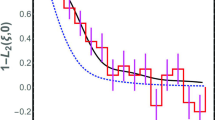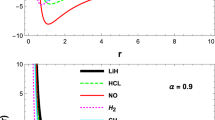Abstract
We model an isothermal aggregation process of particles/atoms interacting according to the Lennard-Jones pair potential by mapping the energy landscapes of each cluster size N onto stochastic networks, computing transition probabilities from the network for an N-particle cluster to the one for \(N+1\), and connecting these networks into a single joint network. The attachment rate is a control parameter. The resulting network representing the aggregation of up to 14 particles contains 6427 vertices. It is not only time-irreversible but also reducible. To analyze its transient dynamics, we introduce the sequence of the expected initial and pre-attachment distributions and compute them for a wide range of attachment rates and three values of temperature. As a result, we find the configurations most likely to be observed in the process of aggregation for each cluster size. We examine the attachment process and conduct a structural analysis of the sets of local energy minima for every cluster size. We show that both processes taking place in the network, attachment and relaxation, lead to the dominance of icosahedral packing in small (up to 14 atom) clusters.













Similar content being viewed by others
Notes
The dataset for LJ\(_{13}\) found in [43] containing 28970 Morse-index one saddles significantly oversamples the set of transition states in comparison with our networks LJ\(_N\), \(N\ge 8\). Therefore, we computed the set of transition states for LJ\(_{13}\) using our technique, so that it is sampled consistently with our networks LJ\(_{N}\), \(6\le N\le 12\) and \(N=14\).
S. Sousa Castellanos (East Carolina University) was M. Cameron’s MAPS-REU student in Summer 2016.
Courtesy of David Wales.
References
Arkus, N., Manoharan, V., Brenner, M.P.: Minimal energy clusters of hard spheres with short ranged attractions. Phys. Rev. Lett. 103, 118303 (2009)
Baletto, F., Rapallo, A., Rossi, G., Ferrando, R.: Dynamical effects in the formation of magic cluster structures. Phys. Rev. B 69, 235421 (2004)
Becker, O.M., Karplus, M.: The topology of multidimensional potential energy surfaces: theory and application to peptide structure and kinetics. J. Chem. Phys. 106(4), 1495 (1997)
Calvo, F., Schebarchov, D., Wales, D.J.: Grand and semigrand canonical basin-hopping. J. Chem. Theory Comput. 12, 902–909 (2016)
Cameron, M., Vanden-Eijnden, E.: Flows in complex networks: theory, algorithms, and application to Lennard-Jones cluster rearrangement. J. Stat. Phys. 156(3), 427–454 (2014)
Cameron, M.K.: Metastability, spectrum, and eigencurrents of the Lennard-Jones-38 network. J. Chem. Phys. 141, 184113 (2014)
Cameron, M.K., Gan, T.: Spectral analysis and clustering of large stochastic networks. Application to the Lennard-Jones-75 cluster. Mol. Simul. 42(16), 1410–1428 (2016)
Carr, J.M., Wales, D.J.: Folding pathways and rates for the three-stranded -sheet peptide Beta3s using discrete path sampling. J. Phys. Chem. B 112, 8760–8769 (2008)
Doye, J.P.K., Wales, D.J., Miller, M.A.: Thermodynamics and the global optimization of Lennard-Jones clusters. J. Chem. Phys. 109, 8143 (1998)
Doye, J.P.K., Wales, D.J., Miller, M.A.: The double-funnel energy landscape of the 38-atom Lennard-Jones cluster. J. Chem. Phys. 110, 6896 (1999)
Weinan, E., Ren, W., Vanden-Eijnden, E.: String method for the study of rare events. Phys. Rev. B 66, 052301 (2002)
Weinan, E., Ren, W., Vanden-Eijnden, E.: Simplified and improved string method for computing the minimum energy paths in barrier-crossing events. J. Chem. Phys. 126, 164103 (2007)
Weinan, E., Zhou, X.: The gentlest ascend dynamics. Nonlinearity 24, 1831–1842 (2011)
Echt, O., Sattler, K., Recknagel, E.: Magic numbers for sphere packings: experimental verification in free xenon clusters. Phys. Rev. Lett. 47(16), 1121–1124 (1981)
Echt, O., Kandler, O., Leisner, T., Mlechle, W., Recknagel, E.: Magic numbers in mass spectra of large van der Waals clusters. J. Chem. Soc. Faraday Trans. 86, 2411 (1990)
Farges, J., de Feraudy, M.F., Raoult, B., Torchet, G.: Structure and temperature of rare gas clusters in a supersonic expansion. Surf. Sci. 106, 95 (1981)
Fejer, S.N., Wales, D.J.: Helix self-assembly from anisotropic molecules. Phys. Rev. Lett. 99, 086106 (2007)
Gao, W., Leng, J., Zhou, X.: Iterative minimization algorithm for efficient calculations of transition states. J. Comp. Phys. 309, 6987 (2016)
Harris, I.A., Kidwell, R.S., Northby, J.A.: Structure of charged argon clusters formed in free jet expansion. Phys. Rev. Lett. 53, 2390 (1984)
Harris, I.A., Norman, K.A., Mulkern, R.V., Northby, J.A.: Icosahedral structure of large charged argon clusters. Chem. Phys. Lett. 130, 316 (1986)
Henkelman, G., Jonsson, H.: A dimer method for finding saddle points on high dimensional potential surfaces using only first derivatives. J. Chem. Phys. 111, 7010 (1999)
Holmes-Cerfon, M., Gortler, S.J., Brenner, M.P.: A geometrical approach to computing free-energy landscapes from short-ranged potentials. Proc. Natl. Acad. Sci. USA 110(1), E5–E14 (2013)
Holmes-Cerfon, M.: Sticky-sphere clusters. Annu. Rev. Condens. Matter Phys. In press (expected 8, March 10, 2017)
Jonsson, H., Mills, G., Jacobsen, K.W.: Nudged elastic band method for finding minimum energy paths of transitions. In: Berne, B.J., Ciccotti, G., Coker, D.F. (eds.) Classical and Quantum Dynamics in Condensed Phase Simulations, vol. 385. World Scientific, Singapore (1998)
Kakar, S., Bjoerneholm, O., Weigelt, J., de Castro, A.R.B., Troeger, L., Frahm, R., Moeller, T.: Size-dependent K-edge EXAFS study of the structure of free Ar clusters. Phys. Rev. Lett. 78(9), 1675–1678 (1997)
Kovalenko, S.I., Solnyshkin, D.D., Verkhovtseva, E.T., Eremenko, V.V.: Experimental detection of stacking faults in rare gas clusters Chem. Phys. Lett. 250, 309 (1996)
Langer, J.S.: Statistical theory of the decay of metastable states. Ann. Phys. 54, 258–275 (1969)
Mandelshtam, V.A., Frantsuzov, P.A.: Multiple structural transformations in Lennard-Jones clusters: generic versus size-specific behavior. J. Chem. Phys. 124, 204511 (2006)
Meng, G., Arkus, N., Brenner, M.P., Manoharan, V.: The free energy landscape of hard sphere clusters. Science 327, 560 (2010)
Miller, M.A., Wales, D.J.: Isomerization dynamics and ergodicity in Ar 7. J. Chem. Phys. 107, 8568 (1997)
Munro, L.J., Wales, D.J.: Defect migration in crystalline silicon. Phys. Rev. B 59, 3969–3980 (1999)
Nocedal, J., Wright, S.J.: Numerical Optimization, 2nd edn. Springer, New York (2006)
Picciani, M., Athenes, M., Kurchan, J., Taileur, J.: Simulating structural transitions by direct transition current sampling: the example of LJ38. J. Chem. Phys. 135, 034108 (2011)
Stillinger, F.H.: Exponential multiplicity of inherent structures. Phys. Rev. E 59(1), 48–51 (1999)
Wallace, D.C.: Statistical mechanics of monatomic liquids. Phys. Rev. E 56(4), 4179–4186 (1997)
Wales, D.J., Doye, J.P.K.: Global optimization by basin-hopping and the lowest energy structures of Lennard-Jones clusters containing up to 110 atoms. J. Phys. Chem. A 101, 5111–5116 (1997)
Wales, D.J.: Discrete path sampling. Mol. Phys. 100, 3285–3306 (2002)
van de Waal, B.W.: No evidence for size-dependent icosahedral \(\rightarrow \) fcc structural transition in rare-gas clusters. Phys. Rev. Lett. 76(7), 1083–1086 (1996)
Wales, D.J.: Energy Landscapes: Applications to Clusters, Biomolecules and Glasses. Cambridge University Press, Cambridge (2003)
Wales, D.J.: Energy landscapes: calculating pathways and rates. Int. Rev. Chem. Phys. 25(1–2), 237–282 (2006)
Wales, D.J.: Energy landscapes of clusters bound by short-ranged potentials. ChemPhysChem 11(12), 2491–2494 (2010)
Zhang, J., Du, Q.: Shrinking dimer dynamics and its applications to saddle point search. SIAM J. Numer. Anal. 50(4), 1899–1921 (2012)
Acknowledgements
This work was partially supported by the NSF Grant DMS1554907 and the NSF REU Grant DMS1359307 at the University of Maryland, College Park.
Author information
Authors and Affiliations
Corresponding author
Rights and permissions
About this article
Cite this article
Forman, Y., Cameron, M. Modeling Aggregation Processes of Lennard-Jones particles Via Stochastic Networks. J Stat Phys 168, 408–433 (2017). https://doi.org/10.1007/s10955-017-1794-y
Received:
Accepted:
Published:
Issue Date:
DOI: https://doi.org/10.1007/s10955-017-1794-y




